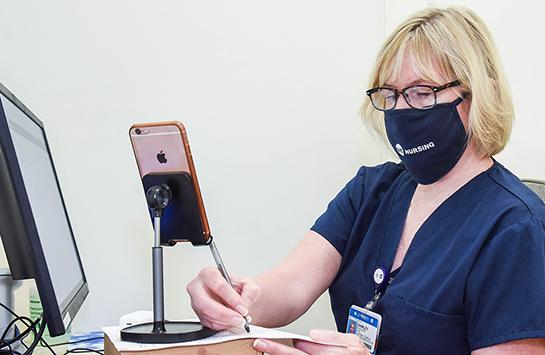UIC Nursing study: Clinic no-show rates dropped with telehealth

No-show rates dropped significantly and there was an increase in new-patient visits at the UIC College of Nursing nurse-managed clinic after it transitioned to telehealth last spring in response to the COVID-19 pandemic, according to an article published in a March/April special telehealth issue of the Journal for Nurse Practitioners.
The no-show rate at the clinic, located in Chicago’s Humboldt Park neighborhood, dropped to 10% for behavioral health patient visits and 15% for primary healthcare visits when services were offered via telephone and videoconference — down from an average no-show rate of around 30% throughout 2019, according to the paper, “Transition of Nurse Practitioner Faculty Practice and Student Clinicals to Telehealth: Response to the COVID-19 Pandemic.”
“I think it was a huge surprise,” says UIC Nursing clinical associate professor Lauren Diegel-Vacek, lead author on the paper and director of the college’s DNP program. “It made us stop and reflect: Are there barriers that our patients face in seeking care? Maybe it’s because they have to work or have other commitments. It’s not easy to carve out time and get transportation to get to a health care visit.”
The paper focused on lessons learned from the shift to telehealth by the college’s Mile Square Health Center — Humboldt Park, a federally qualified health center, as well as a pulmonary subspecialty outpatient clinic at UI Health. The latter’s shift to telehealth was co-led by UIC Nursing executive associate dean Susan Corbridge, a co-author on the paper whose faculty practice is housed there. The paper’s other two authors are also UIC Nursing faculty: clinical assistant professors Karen Cotler, and Virginia Reising.
Both practices had primarily offered only face-to-face care prior to the pandemic, and the paper details challenges experienced at the beginning where they cycled through telehealth platforms and worked to integrate students so they could continue gaining clinical skills. Diegel-Vacek says this was a common story across the country.
“We heard from so many colleagues, how they were struggling to care for the patients that counted on them,” she said.
MSHC-Humboldt Park is located in a low-income, medically underserved community, serving a diverse population predominantly insured by Medicaid. The center leadership and staff worked tirelessly to maintain patient care continuity. Those patients preferred audio phone calls to video visits, which “eliminated the provider’s ability to observe the subtle nuances visible by videoconference,” the authors wrote.
In response, the nurse practitioners developed skills to assess patients by audio, including refining the questions they asked to elicit focused answers, according to the paper.
At both clinics, faculty used the opportunity to teach effective telehealth visit practices to students, including best practices for communicating with patients and for teaching patients to use the new platforms.
For instance, at the pulmonary clinic, an interprofessional practice where providers usually conduct respiratory physical exams in person, they learned to assess for breathlessness on exertion by observing patients walking around their homes, according to the paper.
“Our patients are at incredibly high risk for having poor outcomes if they contract COVID-19 and many feared leaving their homes, making telehealth the only option for them,” Corbridge said. “We found communication to be key. Students conducted ‘pre-calls’ to patients to collect updated information, hear their concerns, and perform a health assessment before the virtual visit. We also had daily virtual team meetings before and after the visits to review what we learned.”
According to the paper, the Coronavirus Aid, Relief and Economic Security (CARES) Act allowed for changes to payer reimbursement for telehealth, which extended coverage to include audio-only platforms, adjusted reimbursement rates to be on par with face-to face, and gave flexibility for the location of the patient and provider.
“Everyone keeps saying telehealth is not the future; it’s the present,” Diegel-Vacek said. “It’s been here, it just hasn’t been maximized. It really does improve access to care for many people.”
